|
|
|
Sort Order |
|
|
|
Items / Page
|
|
|
|
|
|
|
| Srl | Item |
| 1 |
ID:
121016
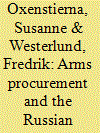

|
|
|
|
|
| Publication |
2013.
|
| Summary/Abstract |
The Russian government has launched a new state armament program for the period 2011-2020 in a decisive effort to bring the Russian Armed Forces into the 21st century. This article investigates the prerequisites for the successful fulfillment of this program and assesses the industry's ability to meet the program's demands. The main findings are that the costs of the program are unrealistically high and that deficiencies in the procurement system and in the technologies and performance of the industry present serious challenges and obstacles that will hinder the fulfillment of the program.
|
|
|
|
|
|
|
|
|
|
|
|
|
|
|
|
| 2 |
ID:
189967
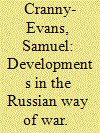

|
|
|
| 3 |
ID:
130662
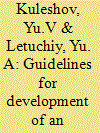

|
|
|
|
|
| Publication |
2014.
|
| Summary/Abstract |
The article discusses recommendations to make the activities of the Russian Armed Forces environment friendly. Topics discussed include details of the environmental safety doctrine for the Armed Forces' activities, development of general standards of environmental safety of weapon and military equipment systems and complexes, constraints to reform. Recommendations include a process approach Armed Forces Environmental Safety Manual and regulations for environmental safety maintenance agencies.
|
|
|
|
|
|
|
|
|
|
|
|
|
|
|
|
| 4 |
ID:
133316
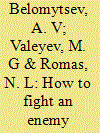

|
|
|
|
|
| Publication |
2014.
|
| Summary/Abstract |
The authors discussed the specifics of fighting against an enemy attacking from aerospace with focus on significant differences in the actions taken by the friendly aerospace defence forces and the weapons they use in comparison with those of the strike (attacking) forces, and express their views on the best ways of using these elements of the Russian Armed Forces in one form or another.
|
|
|
|
|
|
|
|
|
|
|
|
|
|
|
|
| 5 |
ID:
178271
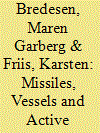

|
|
|
|
|
| Summary/Abstract |
In 2019, Russia’s Chief of the General Staff, Valery Gerasimov, presented a ‘strategy of active defence’, a possible prelude to the forthcoming Russian military doctrine. This article examines this strategy with particular emphasis on the role of precision-guided missiles, tactical nuclear weapons and the role of the navy. It provides insights on the shape of new Russian military doctrine and the military threat Russia might represent to the West. Maren Garberg Bredesen and Karsten Friis conclude that the active defence concept may imply a lowering of the use-of-force threshold. Russia’s continued build-up of tactical nuclear weapons integrated into the conventional forces reinforces this concern.
|
|
|
|
|
|
|
|
|
|
|
|
|
|
|
|
| 6 |
ID:
121559
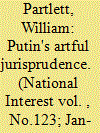

|
|
|
|
|
| Publication |
2013.
|
| Summary/Abstract |
AT 8:00 P.M., Moscow time, on September 21, 1993, Russian president Boris Yeltsin read out an emergency decree on national television. Blaming Russian parliamentary leaders for ignoring the will of the Russian people, Yeltsin abolished the existing constitution and disbanded every legislative assembly in Russia. Russian parliamentary leaders immediately called an emergency session and removed Yeltsin for treason. They named his vice president, Alexander Rutskoi, acting president. The Russian Constitutional Court chairman, Valery Zorkin, then appeared before Parliament and reported that a majority of the court had found Yeltsin's decree unconstitutional. Russia now had two presidents.
|
|
|
|
|
|
|
|
|
|
|
|
|
|
|
|
| 7 |
ID:
171561
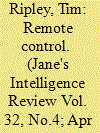

|
|
|
| 8 |
ID:
130023
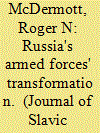

|
|
|
|
|
| Publication |
2014.
|
| Summary/Abstract |
Since the creation of the Armed Forces of the Russian Federation in 1992, the Kremlin has grappled, struggled or even procrastinated on addressing the question of what type of force structure may best suit the state's security environment. A number of initiatives frequently represented as 'reform' have come and gone, falling by the wayside due to internal inertia, institutional resistance to root and branch reform or, indeed, as a result of the political-military elite failing to come to terms with the disintegration of the Soviet Union. Transitioning from the Soviet legacy force to something more akin to the forces needed to protect the Russian state and adapt to the modern warfare environment to meet a number of differing challenges ranging from counterinsurgency to peacekeeping or dealing with an unforeseen military crisis plagued Moscow's defense planning.
|
|
|
|
|
|
|
|
|
|
|
|
|
|
|
|
| 9 |
ID:
171682
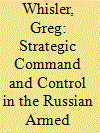

|
|
|
|
|
| Summary/Abstract |
This article is the second in a series of three that examines the Russian Armed Forces’ efforts to adjust its strategic command and control architecture in the post-Soviet period, taking into account wide-ranging shifts in force structure, missions, geography, resources, and leadership. From 2007 through late 2012, the Russian military was gripped with sweeping, painful, and controversial reforms implemented by Defense Minister Anatoliy Serdyukov and Chief of the General Staff Nikolay Makarov. Among many drastic changes, Serdyukov and particularly Makarov finally re-apportioned strategic C2 responsibilities between the General Staff, military districts, and service Main Commands. The latter were relegated largely to ‘train and equip’ roles, while the military districts became truly ‘joint’ commands, and the General Staff became the authority for all operational and strategic planning. The reforms were nascent by the time of abrupt military leadership changes in late 2012 and were not without flaws, but they were a critical breakthrough that simplified and rationalized roles and responsibilities at the highest levels of the Russian military.
|
|
|
|
|
|
|
|
|
|
|
|
|
|
|
|
| 10 |
ID:
170486
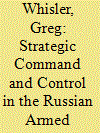

|
|
|
|
|
| Summary/Abstract |
This article is the first in a series of three that examines the Russian Armed Forces’ efforts to adjust their strategic command and control architecture in the post-Soviet period, taking into account wide-ranging shifts in force structure, missions, geography, resources, and leadership. From 1996 to 2000, changes reflected Russian military reform more broadly: much conceptualization, but little implementation. In the first four years of Putin’s presidency, the military leadership advocated strategic command and control reforms, but remained focused on more fundamental issues of military readiness, service conditions, and downsizing. More wide-ranging changes began in earnest in the mid-2000s, only to be overtaken by an even more fundamental defense reform process initiated in 2007. The process of changing the strategic C2 system captured many political, cultural, and strategic facets of post-Soviet Russian military development.
|
|
|
|
|
|
|
|
|
|
|
|
|
|
|
|
| 11 |
ID:
173245
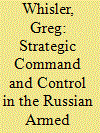

|
|
|
|
|
| Summary/Abstract |
This article is the final in a series of three that examines the Russian Armed Forces’ efforts to adjust its strategic command and control architecture in the post-Soviet period, taking into account wide-ranging shifts in force structure, missions, geography, resources, and leadership. President Vladimir Putin somewhat abruptly installed a new leadership tandem at the Ministry of Defense in late 2012, prompting a backlash against the wrenching defense reforms of the preceding four years. The new strategic command and control system established during the reforms came under scrutiny, but Russian military leaders ultimately determined that with some relatively minor adjustments, the system was ideal. This relatively flat and well-organized strategic command and control system has already demonstrated its effectiveness in Ukraine and Syria. More broadly, the 20-year process of forming this system was one of the most important facets of Russia’s post-Soviet defense reform process and probably the most successful.
|
|
|
|
|
|
|
|
|
|
|
|
|
|
|
|
| 12 |
ID:
126467
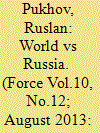

|
|
|
|
|
| Publication |
2012.
|
| Summary/Abstract |
Despite a multitude of various official doctrines and concepts, the Russian approach to strategic policy and national defence planning still remains internally inconsistent and haphazard. The Russian National Security Doctrine-2020, approved by erstwhile President Dmitry Medvedev in May 2009 (and clearly developed under the guidance of Vladimir Putin) is largely devoid of any political commitments or meaningful strategies. The situation results from the fact that Russia has yet to overcome the crisis of national identity since the break-up of the former Soviet Union. The Russian nation and the political elite have not yet reached a comfortable level of consensus regarding post-Soviet Russia's national goals, values and political orientation. That is why Russian politics is an odd mix of the old and the new; Russia wants to modernise, but it also wants to keep its old values. Part of it wants to be pro-West, but another part remains staunchly anti-West. This conflict stands in the way of clearly defining the national goals, as well as the objectives to be set before the Russian armed forces, the nature of the threats for the country, and the list of its potential adversaries. Answers to these important questions are often being given 'on the hoof', often as a knee-jerk reaction to whatever challenges, threats or problems the country happens to be facing at any given moment. This fundamental deficiency defines the current state of Russian foreign and defence policy, as well as Russian strategic planning.
|
|
|
|
|
|
|
|
|
|
|
|
|
|
|
|
|
|
|
|
|